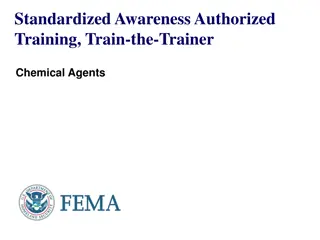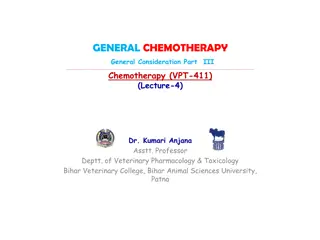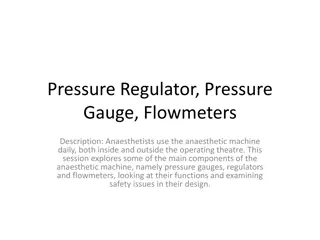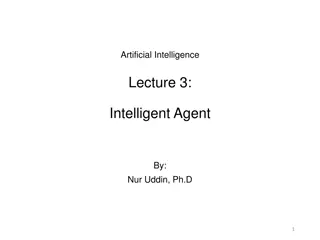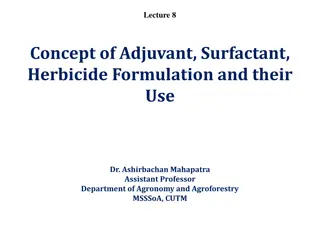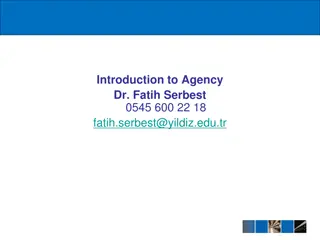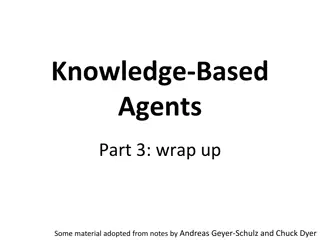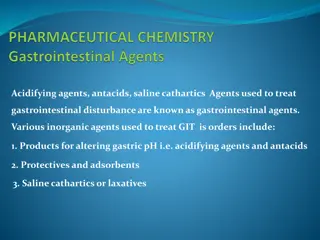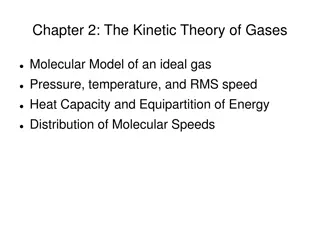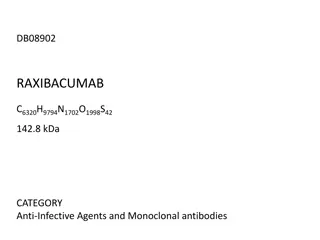Properties of Ideal Inhalational Anaesthetic Agents
Key concepts in understanding inhalational anaesthetic agents, including factors affecting anesthetic uptake, unitary hypothesis, clinical considerations, and properties of the ideal agent for anesthesia delivery.
Uploaded on Feb 28, 2025 | 0 Views
Download Presentation

Please find below an Image/Link to download the presentation.
The content on the website is provided AS IS for your information and personal use only. It may not be sold, licensed, or shared on other websites without obtaining consent from the author.If you encounter any issues during the download, it is possible that the publisher has removed the file from their server.
You are allowed to download the files provided on this website for personal or commercial use, subject to the condition that they are used lawfully. All files are the property of their respective owners.
The content on the website is provided AS IS for your information and personal use only. It may not be sold, licensed, or shared on other websites without obtaining consent from the author.
E N D
Presentation Transcript
Key concepts 1. difference between inspired and alveolar concentration, and the slower the rate of induction. 2. Three factors affect anesthetic uptake: solubility in the blood, alveolar blood flow and the difference in partial pressure between alveolar gas and venous blood. 3. Low output states predispose patients to over dosage with soluble agents, as the rate of rise in alveolar concentrations will be markedly increased. 4. Many of the factors that speed induction also speed recovery: elimination of rebreathing, high fresh gas flows, low anesthetic circuit volume, low absorption by the anesthetic circuit, decreased solubility, high cerebral blood flow, and increased ventilation. 5. The unitary hypothesis proposes that all inhalational agents share a common mechanism of action at the molecular level. This is supported by the observation that the anesthetic potency of inhalation agents correlates directly with their lipid solubility. The greater the uptake of anesthetic agent, the greater the
Con 6. an inhalational anesthetic that prevents movement in 50% of patients in response to a standardized stimulus (e.g. surgical incision). 7. Prolonged exposure to anesthetic concentrations of nitrous oxide can result in bone marrow depression (megaloblastic anemia) and even neurological deficiencies (peripheral neuropathies). 8. Halothane hepatitis is extremely rare (1 per 35000 cases). Patients exposed to multiple halothane anesthetics at short intervals, middle aged obese women, and persons with a familial predisposition to halothane toxicity or a personal history of toxicity are considered to be at increased risk. Isoflurane undergo much less metabolism than halothane, resulting in fewer of the metabolite protein adducts that lead to immunologically mediated hepatic injury. 9. Isoflurane dilates coronary arteries, but is not nearly as potent a dilator as nitroglycerin or adenosine. Dilation of normal coronary arteries could theoretically divert blood away from fixed stenotic lesions. 10. Non pungency and rapid increase in alveolar anesthetic concentration make sevoflurane an excellent choice for smooth and rapid inhalation inductions in pediatric and adult patients. The minimum alveolar concentration (MAC) is the alveolar concentration of
Properties of the ideal inhalational anaesthetic agent (1) Pleasant odor, non-irritant to the respiratory tract and allow pleasant and rapid induction of anaesthesia. (2) Low blood/ gas solubility, which permits rapid induction of and rapid recovery from anaesthesia. (3) Chemically stable in storage, not interact with the material of anaesthetic circuits or with soda lime. (4) Neither flammable nor explosive. (5) Produce unconsciousness, analgesia and some degree of muscle relaxation. (6) Potent enough to allow the use of high inspired oxygen concentration.
Con (7) Not metabolized in the body, non- toxic and not provoke allergic reactions. (8) Minimal depression of CVS and RS and should not interact with other drugs used commonly during anaesthesia e.g. presser agents or catecholamines. (9) It should be completely inert and eliminated completely and rapidly in an unchanged form via the lungs.
Minimum alveolar anaesthetic concentration (MAC) The minimum alveolar concentration (MAC) is the alveolar concentration of an inhalational anesthetic that prevents movement in 50% of patients in response to a standardized stimulus (e.g. surgical incision).
MAC values vary under the following circumstances (1) in pre medicated patients. (2) in presence of N2O. (3) Change in some diseases, e.g. in thyrotoxicosis and in myxoedema. (4) in pyrexia. (5) in sympathoadrenal stimulation induced, for example, by hypercapnia. (6) with advancing age. MAC is higher in infants and neonates than in adults and with advancing years. (7) Drugs which affect release of CNS neurotransmitters affect MAC. MAC in the presence of ephedrine and by methyldopa, pancuronium and clonidine. (8) As atmospheric pressure , MAC , and vice versa
Halothane Colorless liquid with a relatively pleasant smell. A relatively low blood/gas solubility coefficient, thus induction of anaesthesia is relatively rapid. Approximately 20% metabolized in the liver.
RS: Non irritant and pleasant to breathe during induction. There is rapid loss of pharyngeal and laryngeal reflexes and inhibition of salivary and bronchial secretions increase in ventilatory rate and reduction in tidal volume. PaCO2 increases as the depth of halothane anaesthesia increases. Halothane antagonizes bronchospasm and reduces airway resistance in patients with bronchoconstriction.
CVS: Halothane is a potent depressant of myocardial contractility. Thus, there is a reduction in arterial pressure. Reduction in heart rate which is treated by atropine and this will improve the blood pressure. Arrhythmias are very common during halothane anaesthesia and fare more frequent than with isoflurane.
Arrhythmias are produced by: (1) Increased myocardial excitability augmented by the presence of hypercapnia, hypoxaemia or increased circulating catecholamine. (2) Bradycardia caused by central vagal stimulation. During local infiltration with adrenaline or adrenaline containing local anaesthetic solutions, multifocal ventricular extra systoles and sinus tachycardia have been observed and cardiac arrest has been reported.
Thus, caution should be exercised when these solutions are used. The following recommendations have been made: (1) Avoid hypoxaemia and hypercapnia. (2) Avoid concentration of adrenaline greater than 1 in 100 000. (3) avoid a dosage in adults exceeding 10 ml of 1in 100 000 adrenaline in10 min or 30 ml per h. So that doses of epinephrine above 1.5 mcg/kg should be avoided.
Cerebral: By dilating cerebral vessels, halothane lowers cerebral vascular resistance and increases CBF. Autoregulation, the maintenance of constant CBF during changes in arterial blood pressure, is blunted. Concomitant rises in intracranial pressure can be prevented by establishing hyperventilation prior to administration of halothane. Cerebral activity is decreased, leading to EEG slowing and modest reductions in metabolic oxygen requirements.
Renal: Halothane reduces renal blood flow, glomerular filtration rate, and urinary output. Part of this decrease can be explained by a fall in arterial blood pressure and cardiac output. Because the reduction in renal blood flow is greater than the reduction in glomerular filtration rate, the filtration fraction is increased. Preoperative hydration limits these changes.
Hepatic: Halothane causes hepatic blood flow to decrease in proportion to the depression of cardiac output. Hepatic artery vasospasm has been reported during halothane anesthesia. The metabolism and clearance of some drugs (e.g. fentanyl, phenytoin, and verapamil) seem to be impaired by halothane.
Pregnant uterus: Halothane relaxes pregnant uterine muscle and cause post-partum haemorrhage. A concentration of less than 0.5% is not associated with increased blood loss during anaesthesia for CS, but causes increased blood loss during therapeutic abortion.
Skeletal muscle: Halothane causes skeletal muscle relaxation and potentiates non depolarizing relaxants. Post-operatively, shivering is common; this increases oxygen requirements and results in hypoxaemia unless oxygen is administered.
Contraindications: It is prudent to withhold halothane from patients with unexplained liver dysfunction following previous anesthetic exposure. Halothane, like all inhalational anesthetics, should be used with care in patients with intracranial mass lesions because of the possibility of intracranial hypertension secondary to increased cerebral blood volume and blood flow. Hypovolemic patients and some patients with severe reductions in left ventricular function may not tolerate halothanes negative inotropic effects. Sensitization of the heart to catecholamines limits the usefulness of halothane when exogenous epinephrine is administered or in patients with pheochromocytoma.
Drug interactions: The myocardial depression seen with halothane is exacerbated by adrenergic blocking agents and calcium channel blocking agents. Tricyclic antidepressants and monoamine oxidase inhibitors have been associated with fluctuations in blood pressure and arrhythmias, although neither represents an absolute contraindication. The combination of halothane and aminophylline has resulted in serious ventricular arrhythmias.
In Summary halothane is very useful inhalational anaesthetic agent. Its main advantages are: (1) Rapid, smooth induction. (2) Minimal stimulation of salivary and bronchial secretions, prior administration of atropine is unnecessary. (3) Bronchodilatation. (4) Muscle relaxation. (5) Relatively rapid recovery.
Con The disadvantages are: (1) Poor analgesia. (2) Arrhythmias. (3) Post-operative shivering. (4) Possibility of liver toxicity, especially with repeated administration.


